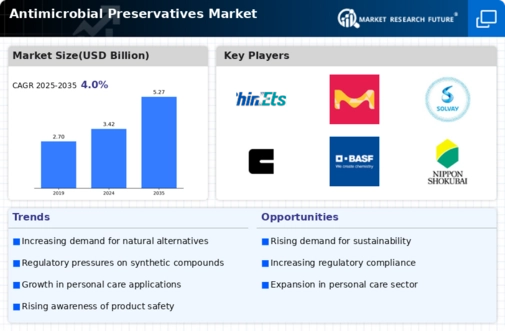The Antimicrobial Preservatives Market is currently characterized by a dynamic competitive landscape, driven by increasing consumer awareness regarding product safety and the growing demand for longer shelf life in various applications, including personal care, food, and pharmaceuticals. Key players such as BASF SE (Germany), Dow Inc. (US), and Lonza Group AG (Switzerland) are strategically positioned to leverage innovation and sustainability in their operations. BASF SE (Germany) focuses on developing bio-based preservatives, which aligns with the rising trend towards eco-friendly products. Meanwhile, Dow Inc. (US) emphasizes digital transformation and supply chain optimization to enhance operational efficiency, while Lonza Group AG (Switzerland) is investing in partnerships to expand its product portfolio and market reach, collectively shaping a competitive environment that prioritizes sustainability and technological advancement.
In terms of business tactics, companies are increasingly localizing manufacturing to reduce lead times and enhance responsiveness to regional market demands. The market structure appears moderately fragmented, with several players vying for market share, yet the collective influence of major companies like Clariant AG (Switzerland) and AkzoNobel N.V. (Netherlands) is notable. These companies are actively engaging in strategic collaborations and acquisitions to bolster their market positions, thereby intensifying competition and driving innovation.
In August 2025, Clariant AG (Switzerland) announced a strategic partnership with a leading personal care brand to develop a new line of antimicrobial preservatives derived from natural sources. This collaboration not only enhances Clariant's product offerings but also positions the company as a frontrunner in the sustainable preservatives segment, catering to the increasing consumer demand for natural ingredients. The strategic importance of this partnership lies in its potential to capture a larger market share in the eco-conscious consumer segment.
In September 2025, Dow Inc. (US) launched a new digital platform aimed at optimizing the supply chain for its antimicrobial preservatives. This initiative is expected to streamline operations and improve customer engagement, reflecting Dow's commitment to leveraging technology for enhanced service delivery. The strategic significance of this move is underscored by the growing need for efficiency in supply chains, particularly in a market that is becoming increasingly competitive.
In July 2025, Lonza Group AG (Switzerland) expanded its manufacturing capabilities in Asia through a significant investment in a new facility dedicated to antimicrobial preservatives. This expansion is indicative of Lonza's strategy to tap into the rapidly growing Asian market, which is witnessing a surge in demand for preservatives across various sectors. The strategic importance of this investment lies in its potential to enhance Lonza's production capacity and responsiveness to regional market needs, thereby strengthening its competitive position.
As of October 2025, the competitive trends in the Antimicrobial Preservatives Market are increasingly defined by digitalization, sustainability, and the integration of artificial intelligence in product development and supply chain management. Strategic alliances are becoming more prevalent, as companies recognize the value of collaboration in driving innovation and market penetration. Looking ahead, competitive differentiation is likely to evolve from traditional price-based competition towards a focus on innovation, technological advancements, and supply chain reliability, reflecting the changing dynamics of consumer preferences and market demands.



















Leave a Comment